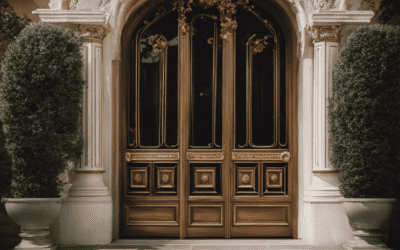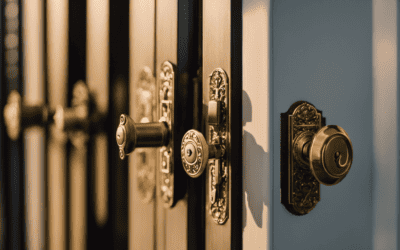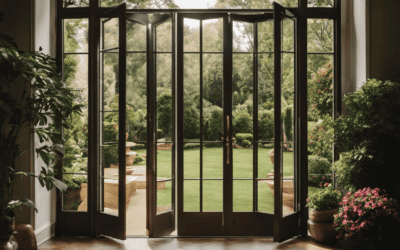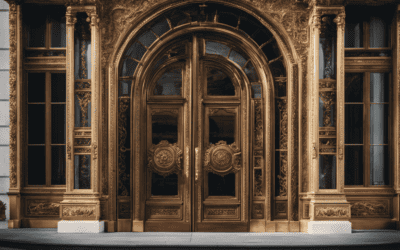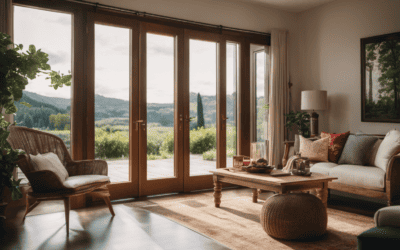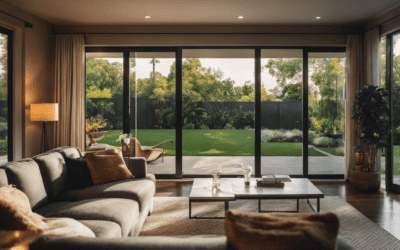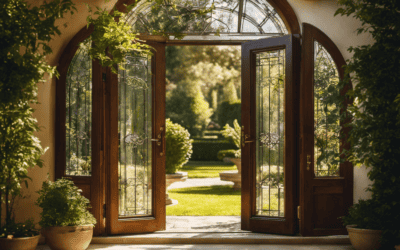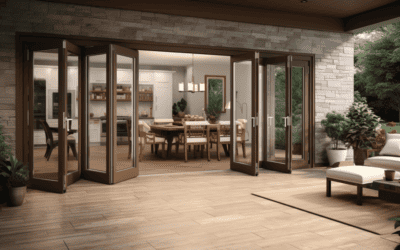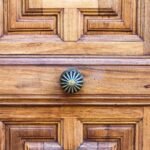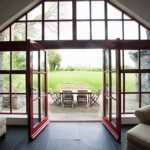
Key takeaways:
- Rebating doors are crucial in French door renovations, ensuring a proper fit and functionality.
- French doors offer aesthetic appeal to any renovation project, adding elegance and charm to the space.
- Security features are important considerations when using French doors, as they provide peace of mind and protection.
How to Rebate French Doors for Renovations
Rebating French doors can be a crucial step in renovating your space. In this section, we will delve into the process of how to rebate French doors, covering everything from understanding the concept of rebating doors to practical tips and techniques. Whether you’re looking to enhance the aesthetic appeal or improve the energy efficiency of your doors, this section will guide you through the ins and outs of rebating French doors for your renovation needs.
Understanding the concept of rebating doors
Rebating doors is the process of cutting grooves or notches into the edges of a door to fit another door or frame. It creates a flush and seamless look when multiple doors are installed side by side. It’s important to understand rebating if you want a visually appealing result with clean lines and no gaps between the doors.
Rebating can give your doors a nice aesthetic and secure them. You can customize them with decorative details like panelling or moulding. The rebate also adds strength, making it harder for intruders to pry open the doors. And if you fit a secure latch, you can get extra peace of mind.
When looking at different types of rebated doors, learn about their features and advantages. Materials like timber, PVCu, or aluminium are usually used due to their durability and weather resistance. Each material has unique properties that contribute to poor performance and longevity.
French doors benefit a lot from rebating, giving them an elegant and cohesive look. They add charm and character to any space. So, if you’re planning a renovation project, consider rebating doors as an option – especially if your in-laws are paying a surprise visit!

The Benefits of Using French Doors in Renovations
French doors are a valuable addition to any renovation project, offering both aesthetic appeal and enhanced security features. In this section, we’ll explore the benefits of using French doors, including their ability to elevate the overall look of a space and provide a seamless transition between indoor and outdoor areas. Additionally, we’ll delve into the importance of security features, ensuring peace of mind without compromising on style.
Aesthetic purposes of French doors
French doors offer not only practicality but also beauty. Their wide glass and intricate designs bring a bright atmosphere and elegance to any space. Natural light fills the area, giving it a spacious vibe and connecting the indoors to the outdoors. They serve as a focal point, attracting attention and creating a smooth boundary between indoor and outdoor living spaces.
The design of French doors is vast. Homeowners can customize the glass – clear or covered with patterns or textures – and the frames – made from wood, aluminium, or vinyl – for a personalized look.
These doors are incredibly versatile, fitting in traditional and modern homes alike. Moreover, they come in various configurations – single or double, hinged or sliding – providing options for different uses and spaces.
The importance of security features for French doors
French doors boast stunning aesthetic appeal and security. With the worry about home safety, it’s important to make sure that French doors have good security features during renovations. Fit locks that are difficult to tamper with. Reinforce glass panels with laminated or toughened glass. Plus, fit door frames and hinges for extra security.
Multi-point locking systems are great for more defence. Deadbolts and cylinder guards can help stop lock picking and cylinder extraction methods. Yet, you don’t want to compromise the look of your French doors. Choose security features that match the design. Choose decorative door handles and finishes that match other hardware elements.
HomeAdvisor.com suggests adding security features to French doors to stop break-ins. Rebated doors offer smooth operation and a stylish look.
Exploring Different Types of Rebated Doors
Rebated doors come in various types, each with its own set of advantages. In this section, we will delve into the features and benefits of rebated doors. We will also explore the materials commonly used to create these doors, providing you with valuable insights for your next home improvement project. So, let’s dive into the world of rebated doors and discover the possibilities they offer for enhancing your space’s functionality and aesthetics.
Features and advantages of rebated doors
Rebated doors provide outstanding features and benefits, making them popular for renovation projects! By having a rebate, the functionality and aesthetics of any space are enhanced.
- Insulation is improved – creating a tight seal when closed, minimising drafts and increasing energy efficiency in the home.
- Soundproofing is upgraded – the rebate helps to reduce sound transmission, so rebated doors are great for rooms requiring privacy or noise control.
- Security is increased – the overlapping nature makes it harder for intruders to force the door open.
- Appearance is neat – the rebate hides gaps between the door and the frame. Plus, there are no exposed edges, making cleaning and maintenance easier.
They are usually made from durable materials like wood, PVC or aluminium. This ensures their longevity and durability in all weather. The tight fit of the rebate stops moisture infiltration, lessening the risk of warping or rotting.
Rebated doors show lots of benefits, such as improved insulation, enhanced soundproofing, increased security, a neat look and easy maintenance. With numerous material options, they are suitable for various architectural styles and preferences.
Materials commonly used for rebated doors
Rebated doors are popular for renovations because of their looks and functionality. There are several materials to choose from, such as:
- Timber: Natural and warm, timber can be stained or painted.
- Composite: Durable, low maintenance, resists rotting, warping and insect damage.
- Aluminium: Lightweight, strong, and corrosion-resistant. It can have thermal breaks for energy efficiency.
- Steel: Offers excellent security and durability, often used in commercial settings.
- Glass: Gives a sense of openness and can come in clear, frosted, or textured glass.
- PVC-U: Weather-resistant, low maintenance, available in various finishes and colours.
Unconventional materials like bamboo or reclaimed wood can also be used as an eco-friendly option. When selecting materials, consider factors like durability, maintenance, weather resistance, design, and budget. High-quality materials are essential to ensure the door looks great and functions well.
Plus, don’t miss out on our step-by-step guide to easily cutting a rebate in French doors!

Step-by-Step Guide: Cutting a Rebate in French Doors
Looking to cut a rebate in your French doors? This step-by-step guide has got you covered. We’ll walk you through the process of choosing the right tools, taking accurate measurements, and implementing proper techniques for a clean and precise rebate. Plus, we’ll explore how to add decorative details to create a symmetrical and visually appealing finish. Get ready to transform your French doors with this comprehensive guide.
Choosing the right tools for cutting a rebate
Cutting rebates in French doors requires the right tools. Start with a quality chisel with a sharp blade for precise cuts. A mallet will help you apply controlled force when striking the chisel. Use a marking gauge or measuring tape to accurately measure and mark where the rebate needs to be cut. Consider a router for quick and efficient results. Sandpaper is good for smoothing the rebate edges, and wood filler is for filling any gaps or imperfections. Routers may not be necessary for smaller rebates or if you prefer manual tools. Ultimately, it depends on your own preferences and experience.
Proper measurements and techniques for cutting the rebate
Accurate cutting of rebates is essential. Measure twice, and cut once.
- Firstly, measure accurately the door frame and the dimensions needed. Both width and depth need to be precise.
- Mark and outline the rebate area with a pencil or marking tool. This will help guide the cutting.
- Choose the right tools: chisels, routers, or table saws, depending on preference and skill. Cut with precision, following the markings on the door frame. Cut slowly, without too much force, to avoid damage.
- Test fit the door into its frame. See if it fits without gaps or obstructions. Trim or file any excess edges to get a seamless fit.
- Attention to detail is key. Measure accurately, use the right tools carefully, and follow the outlined markings.
Pro Tip: Practice on scrap wood before attempting to cut rebates on French doors. This will help you understand techniques and stop mistakes.
Creating a symmetrical look with decorative details
Decorative details are key for a symmetrical French door look. With thoughtfulness, homeowners can elevate the doors’ aesthetic while keeping them balanced and harmonious. Decorative choices depend on personal taste and project style.
To gain a symmetrical look, rosettes or scrollwork may be added to the door’s top, bottom, or sides. Or intricate glass inserts, for both decoration and light, can be used with symmetrical patterns or motifs.
Architectural moulding around door panels or frames adds depth and symmetry. And it is important to select hardware – handles, hinges, knobs – that match in design and finish.
Painting techniques like faux finishes or stencils with symmetrical patterns help achieve balance. Accessories like door knockers or address plaques should fit the overall design theme to complete the look.
Accurate and secure installation is key to maintaining French door functionality and durability. Professional help or guidance during installation is beneficial.
In conclusion, homeowners can create a symmetrical look with decorative details on French doors. They can enhance the aesthetic with carefully selected elements while achieving balance and harmony. Proper installation and attention to detail are essential.

Fitting a Rebated Door Latch: A Guide
Fitting a rebated door latch on your French doors? This guide has got you covered! Discover the essential tools you’ll need and follow step-by-step instructions for a seamless installation. Don’t miss this opportunity to learn the tricks of the trade and ensure your rebated door latch fits perfectly into place.
Tools required for fitting a door latch on a rebated door
Fitting a door latch on a rebated door demands certain tools. This equipment helps to attain the desired security and usability of the door latch.
- Chisel: Necessary for forming the door latch’s recess in the rebated area of the door, a sharp chisel is a must.
- Hammer: Needed to drive the chisel into the wood and create clean cuts.
- Screwdriver: Essential to attach the door latch mechanism to the rebated area of the door.
- Drill: May be necessary for drilling pilot holes or creating recesses for extra screws, according to the kind of door latch used.
- Measuring tape: Precise measurements are vital when fitting a door latch, making sure it aligns properly with the existing door frame.
These tools work together to make sure the door latch fits safely in the rebated area, providing an effective lock for your French doors.
Certain specialized equipment may also be essential depending on individual needs or preferences. But, it is essential to remember that these extra tools are not always necessary and may differ according to different situations.
When fitting a door latch on a rebated door, it is wise to consider any unique details related to the specific situation. For instance, depending on the material of the French doors, you might need different sorts of drills or screws. Additionally, if the rebated doors have ornamental details or trimmings, extra precision may be needed to preserve their appearance while fitting the latch.
Considering these unique details will guarantee proper functionality and preserve the aesthetic appeal of your rebated French doors.
The roots of fitting a door latch on a rebated door can be traced back to the early development of French doors. Initially designed to give an impression of sophistication and elegance while also allowing abundant natural light to enter, the need for door latches on rebated doors arose with the protection concern. Nowadays, with advancements in technology and tools, fitting a door latch on rebated French doors has become more convenient and efficient, permitting homeowners to gain both functionality and aesthetics in their home renovations.
Unlock the secrets to fitting a rebated door latch with these foolproof step-by-step instructions.
Step-by-step instructions for fitting a rebated door latch
Homeowners wanting to add style and functionality to their renovations often choose French doors. A rebated door latch should be fitted to ensure they close securely. Here’s how:
- Mark the spot – Use a pen or marker to accurately note where the latch will go on both the door and the door jamb.
- Chisel out the recess – Carefully chisel out a recess in the door edge and the corresponding area on the jamb. The depth should match the size of the latch.
- Test fit the latch – Fit the latch to ensure it fits snugly. Make adjustments if needed.
- Install and secure – Use screws or nails to secure the latch in place. Make sure it’s aligned properly.
These steps can help you fit a rebated door latch to your French doors. Consider getting professional assistance for complex installations or glass doors. Professional installers have experience fitting them correctly and can help ensure proper functioning and longevity.
Tips and Recommendations for Installing French Doors
In this section, we’ll provide you with valuable tips and recommendations for installing French doors. Whether you’re contemplating seeking professional help or taking on a DIY installation, we’ve got you covered. We’ll also highlight the important considerations you need to consider when installing rebated doors. Get ready to embark on your journey to create a stunning and functional entryway with French doors.
Seeking professional help vs. DIY installation
Regarding fitting French doors, skill and knowledge of carpentry are a must. Hiring a professional guarantees installation is done right and fast, reducing the risk of errors or damage. DIY installation may look cheap but can be time-consuming and laborious. Pros have the tools, experience, and manpower to get the job done quickly.
Safety is another key factor to consider. Not only do these doors look great, they also offer security. Professionals have the expertise to make sure all safety features are installed. Plus, they often offer warranties or guarantees. This protection is not always available with DIY installs.
Hiring pros may cost more upfront, but their expertise can save you from costly mistakes. They often get materials at wholesale prices, offering better deals than individuals. It’s important to consider the cost considerations of professional help vs DIY.
Lastly, compliance with building codes and regulations is essential. Professional installers understand these requirements and will make sure all standards are met. Consider these factors when making the decision.
Important considerations when installing rebated doors
- Measure accurately for a proper fit.
- Align & level for smooth operation.
- Weatherproof for energy efficiency.
- Frame & support for long-term durability.
- Professional help is recommended if unsure.
- Enhance function & aesthetics with careful installation!
Achieving Functionality and Aesthetics with Rebated French Doors
Rebated French doors can add both functionality and style to a space. To ensure this, it is important to pay attention to alignment, security, maintenance, and design.
Firstly, ensure the doors are correctly aligned and fit within the frame. This will ensure smooth and efficient functioning.
The rebating process should also be done carefully for a secure seal, boosting energy efficiency and soundproofing.
Aesthetics are also important. Choose a finish to complement the décor and architectural style for a cohesive look.
Durability and maintenance are also key. Regularly lubricate hinges and clean surfaces to keep the doors looking their best.
Security is yet another factor. Utilize high-quality locking mechanisms and reinforce the frame.
Finally, seek expert advice for proper techniques. This will ensure proper functionality and aesthetics.
To truly stand out, add custom designs and features. Stained glass panels or decorative grille patterns can bring a bespoke touch to the doors.
Rebated French doors have been around since the 17th century. Initially used in grand residences and palaces, they have become popular among homeowners. Proper care and technique can add an optimal balance of functionality and style to any living space.

Some Facts About How To Rebate French Doors:
- ✅ French doors are double doors that meet in the middle and are primarily used for aesthetic purposes. (Source: wonkeedonkeetools.co.uk)
- ✅ Rebated doors are doors that have been cut or designed to come together when closing. (Source: wonkeedonkeetools.co.uk)
- ✅ Rebated doors offer great thermal efficiency and security, as they are tightly closed and can be difficult to open from the outside when locked. (Source: doorsonlineuk.co.uk)
- ✅ It is recommended to attach the lock beforehand when fitting rebated doors, especially for external doors. (Source: doorsonlineuk.co.uk)
- ✅ The process of cutting a rebate in French doors can be done using a table saw or a router. (Source: woodworkforums.com)
Frequently Asked Questions
Can French doors be used for external entrances?
French doors are primarily used for aesthetic purposes and offer little security. They should only be used for internal use and not as external entrances to the property.
What are rebated doors?
Rebated doors are doors that have been cut or designed to come together when closing. They consist of two single doors, with the lip removed from the edges to allow them to interlock.
How do I rebate French doors?
You can use a table saw or a router to rebate French doors. Cut the rebate on the inside of one door and the outside of the other. You may also consider using a veining bit to create a “v” groove for a symmetrical look.
What security mechanisms are recommended for French doors?
For added security, you can use flush bolts, which are not visible from the exterior and provide additional security and structure to the doors. Key-type top and bottom bolts are also a good compromise. Rebate locks can be inserted into the second closing door and secured with a strike plate on the first closing door.
How do I fit a rebate latch on French doors?
You will need a chisel, a flat wood drill bit, and a rebate kit to fit a rebate latch on French doors. Follow the step-by-step guide in the provided blog post to chisel out a space for the latch, drill a hole, and install the latch and strike plate.
Can I use a door pair maker instead of rebated doors?
You can use a door pair maker if you don’t want to replace your double doors with rebated doors. A door pair maker is a piece of wood that adds a lip to the door, excluding drafts and enhancing security.
Related Articles:
How to Keep a French Door Closed
Are you tired of struggling to keep your French doors closed and secure? Well, fear not! We've covered you with some practical tips and tricks to help you keep those doors shut tight. From installing high-quality deadbolts and hardware designed specifically for French...
Who Makes the Best French Doors
We've got you covered when it comes to finding the best French doors for your home. We know that homeowners like you want doors that not only enhance the beauty of your space but also let in plenty of natural light. That's why working with a skilled contractor with...
The Ins and Outs of French Door Construction: Are They Double Pane
Did you know that French doors are a popular choice among homeowners? They not only add elegance to a space, but they also provide timeless design. One important consideration regarding French door construction is whether they are double pane. Double-pane glass offers...
Different Types of French Door Locks
Are you looking to enhance the security of your French doors while maintaining the elegance they bring to your home? Look no further! In this article, we'll guide you through the different types of locks available for French doors. From surface-mounted locks that are...
How Far Do French Doors Open
Have you ever wondered how far French doors can swing open? Well, let us shed some light on this fascinating topic. When fully open, standard French doors can reach a width of about 5 feet. However, the range of motion can vary depending on various factors. Outswing...
What Is the Proper Name for French Doors
As we explore the proper name for French doors, let us open the doors of knowledge and shed light on this timeless architectural feature. With their charming glass panes and undeniable elegance, French doors have graced homes for centuries. They have become synonymous...
Should French Doors Open Inwards or Outwards
We all want our homes to reflect our style and provide a sense of belonging. And when it comes to French doors, deciding whether they should open inwards or outwards is important. Did you know that choosing the right direction can impact the functionality and security...
What Is Safer Sliding Glass Door or French Doors
When choosing between sliding glass doors and French doors, we all want to feel safe and secure in our homes. So, which option is safer? Let's dive into the details and explore the facts. Sliding glass doors may offer convenience, but hinged French doors have more...
Do French Doors Use Tempered Glass
We know what you might be thinking - do French doors need tempered glass? The answer is a resounding yes! Like any other doors in buildings, French doors must use tempered glass for safety reasons. Tempered glass is solid and breaks into harmless pieces, making it...
How Long Do Wood French Doors Last With Glass
Did you know that French wood doors with glass can last for a significant amount of time if they are made from rot-resistant wood species and properly maintained? These elegant doors can add a touch of timeless beauty to any home. In this article, we will explore the...
Are Bifolds More Expensive Than French Doors
Imagine standing at the threshold of your dream home, trying to decide between bifold and French doors. As we delve into whether bi-folds are more expensive than French doors, let us guide you through the intricacies and considerations that come into play. From the...
Do Roller Blinds Work On French Doors
Sick of battling the sun every time you open your beautiful French doors? Welcome to the club. Those gorgeous panes of glass let in tons of natural light but can turn your home into a sauna on hot days. Not to mention, privacy goes out the window (literally!) Luckily,...
Message Us
Get In touch below. Ask Any Question or Start a Free Quote
Call Us
1800 491 492
I'm James Davis, a carpenter with eight years of experience in carpentry services, repairs, installations, renovations, and maintenance of interior doors. I have a diploma in carpentry and joiner trade from the Education Skills Australia Institute and take pride in delivering high-quality results to ensure customer satisfaction. I'm a blog writer for Octopus Doors Company and enjoy sharing my knowledge and tips on maintaining security measures and choosing the right door materials, paints, or handle styles. I specialize in custom-made interior doors and strive to make every home look fabulous. Contact me anytime for help with door-related issues.


